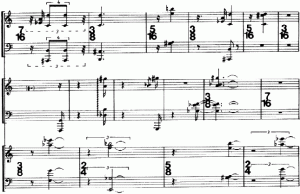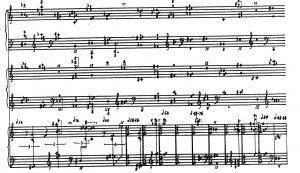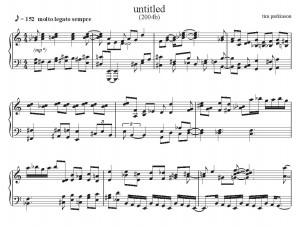I’ve often felt that Morton Feldman was on a lifetime search for a notation that suited the sounds he wanted. His definition of composition may have been ‘the right note in the right place with the right instrument’[1] but that elusive ‘right place’ seemed always to be ill-suited to music notation of any kind. Very often it would appear he got it wrong. The early graph notations (which notated sequence of events but not the events themselves, beyond which register they appear) resulted in performances of which he didn’t approve because performers chose not to play the notes he would have wanted them to. The traditionally notated pieces of the 1950s were too formal for his desired elasticity of time (though I love these pieces, which remind me of the gorgeous Webern pieces from the 1909-15 period). The pieces, such as the Durations series, which notate all sounds but not how they are aligned rhythmically, also resulted in performances which he didn’t like, such as the infamous performance of Piece for 4 pianos in which Cage finished approximately 20 minutes after everyone else (after which Feldman didn’t speak to Cage for weeks). Many of the works composed during the 1960s would appear to be the height of Feldman’s notational experiments, and are the subject of this blog, but the next phase of Feldman’s compositional output sees a return to a much more conventional style of music notation, in the works of the 1970s, and are arguably his least contentious works in terms of notation. However he soon moved on from this phase and his last great works, those composed from around 1977 to his death in 1987, include works of extraordinary complexity in rhythm and ensemble coordination. Some of these works are almost designed to ‘fail’ such as the three layers of piano music in Piano (1977), which are impossible to play strictly as notated.

I am about to embark on a recording project focussing upon the works for multiple pianos and piano(s) + ensemble Feldman composed mostly over the late 1950s and into the 1960s.[2] It is these works, some of which were previously unknown to me (how many people know the Two Pieces for 3 Pianos?), which have prompted this blog. There is an extraordinary and tangible sense of Feldman digging deep into the possibilities of rhythmic notation here. I get such a thrill looking through these pieces and seeing the slightly different ways Feldman teases the notational schemes, shifting from one to another and combining them in highly idiosyncratic ways. This is very much ‘experimental music’ in two senses, whereby the composer is experimenting with notational possibilities, and at the same time there is a sense of discovery through performance itself.
None of the pieces we’re recording use entirely traditional music notation, though all (with the exception of Projections 3) are pitch specific. The range of notations include: pieces where the pitches are allocated noteheads but no rhythmic value (other than the usual ‘slow’ or ‘very slow’), where the performers simply move through the score together, such as Piano (Three Hands) (1957); pieces where again noteheads are all that are notated but the performers move independently (Piece for 4 Pianos (1957), Two Pianos (1957), Piano Four Hands (1958)); one piece in which players play independently and choose the order of events (Intermission 6 (1953)); pieces which mix events played together with events played in succession, with the instruction to enter ‘as the preceding sound begins to fade’ (Vertical Thoughts I (1963), De Kooning (1963)); and, finally, three extraordinary works which divide the ensemble into smaller ensembles, with some musicians playing rhythmic notation, others playing independently, others playing in non-rhythmic coordination, all at the same time (Two Pieces for 3 Pianos (1966), False Relationships and the Extended Ending (1968), and Between Categories (1969)).
In many ways these last three works look, from the notational design, set to fail. How can these work as ensemble pieces when the different members of the ensemble are existing in entirely different time planes? However, I have found Brett Boutwell’s article ‘”The Breathing of Sound Itself”: Notation and Temporality in Feldman’s Music to 1970’ (Contemporary Music Review, 32/6 (2013), 531-570) to be extremely helpful in gaining some understanding of these works. Boutwell argues convincingly, drawing upon Feldman’s own words, for the visual obfuscation of Feldman’s notation as a deliberate aesthetic choice. Whilst I’ve always accepted this in relation to the early and late works (in very different ways), the highly unusual layouts of these works from the 1960s I confess to having often considered as the best job from a poor set of options! But Boutwell describes these works as being conceived of ‘vertically’, with the goal of ‘creating aesthetically static music lacking explicit audible contrast’. Thinking of the music ‘conceptually’ in this way means that the lack of vertical alignment across instruments in these pieces makes no difference to the character of the music as it is conceived vertically as a whole. Hence the series of pieces to which Feldman gave the title – ‘Vertical Thoughts’.
Thinking of the music afresh in this way has meant that I’m approaching these scores not so much with the question ‘Is this what he meant?’ but now ‘What’s this going to sound like?’ I get the feeling that performing these works will be really an experiment in sound, that the performers will be at the heart of the experiment. So I am labelling this blog as ‘part 1’; part 2 will appear after the rehearsals and recordings have taken place. Practising these pieces at home I have no idea really quite how they will sound, at least in their detail (and I generally avoid listening to recordings whilst preparing for a performance). So as I continue delving into the notations and feeling my way round the piano notes, in advance of the rehearsals with the full ensembles, there are a number of questions that are posed by these scores to which I don’t have answers as yet:

- The rhythm-less noteheads: Feldman specifies each sound played by the first two pianos in ‘Two Pieces for Piano’ (see above) is to be held ‘until it begins to fade’. Is this a vague way of indicating a sort of tempo? (In ‘Between Categories’ the instructions simply state ‘Durations of simultaneous and single sounds are extremely slow’, but much of this piece is notated within a metre with tempo indications, which suggests that these single sounds are simply very isolated, unmeasured, events.) Or do I take each sound on its own merits and listen carefully to the envelope of the sound? When does a piano sound fade? Immediately? Or is there a point sometime after the attack at which one feels it perceptibly starts to fade? When the dynamics are so low anyway, these are subtle points! And how different is this point in the different registers? Certainly the upper octave notes don’t so much fade as disappear almost instantly! And how am I going to be able to hear these ‘fade points’ amidst the sounds of the rest of the ensemble?
- Connecting noteheads: in the second of the ‘Two Pieces for Three Pianos’ Feldman connects sounding events across the ensemble by dotted lines and the instruction ‘Each piano enters as the preceding sound begins to fade’. Obviously the same issues as I described in the point above are in play here, but I wonder how different it is to hear the ‘fade point’ of sounds I’ve made, with my instrument, in comparison with those someone else has made, on their instrument. This ‘cue-ing’ notation I realise now is very similar to the kinds of notations Christian Wolff was exploring in the early 1960s, a connection I’d not made before. For sure the aims were very different, but, as Michael Hicks has argued in his chapter ‘”Our Webern”: Cage and Feldman’s Devotion to Christian Wolff’ (in Chase, Thomas (eds) (2010) Changing the System: the Music of Christian Wolff (Ashgate, Farnham) 3-22) Feldman was greatly inspired and influenced by Wolff in ways that shaped aspects of his later music.[3] Feldman’s De Kooning, which uses this notation for the first time, was composed in 1963, a year after Wolff’s For 5 or 10 Players and the year before For 1, 2 or 3 Players. It’s fascinating that both players – in complete contrast to Cage – were exploring ways of performance which depended upon other players for the rhythmic placing of events.
- Black noteheads vs white noteheads: what’s the difference? Feldman mostly (in these pieces) uses black noteheads, but does also notate some pitches as white noteheads. Are these meant to be more ‘measured’? (are they semibreves?) Or do they affect articulation in some way? Why also are some grace notes white noteheads? Likewise, I’m absolutely sure that a single stemless chord is approached differently in performance from one which is, say, a semibreve within a 2/2 bar. The articulation somehow feels more attacked in the latter, due to the chord’s relationship to the barline, whilst the stemless chord feels to be outside of time, to have no gravitational force against which to be measured.
- Ensemble coordination: in the first of the ‘Two Pieces for Three Pianos’ the first and second pianos are notated entirely as stemless noteheads, as described above, whilst the third piano is notated with a succession of different tempo marks, bar lines and rhythmic notation (see example above). I have no idea whether or not we will all finish at roughly the same time, or whether we will entirely at odds with each other. I wonder how closely Feldman thought through what he felt the durations of each part would be, and whether he intended for them to last approximately similar durations? The third piano part is not notated spacially in any case: the first bar lasts about 8 seconds, whilst the next seven bars, which are together arranged over the same amount of space as taken by the first bar, lasts about 50 seconds. There is thus no way that the visual alignment between pianos 1 and 2 and piano 3 is reflected aurally. I am extremely curious as to how it works out in rehearsal, and also what we will as a group decide to do about it. Will we decide to adapt our understanding of the durations of pianos 1 and 2 to better ‘fit’ piano 3? Or will we agree to remain doggedly independent? After all, this is not Cage… or is it…? In ‘Between Categories’ the two ensembles are mostly notated in measured time, but there are sufficient unmetred sections within each to ensure the ensembles are not to be forced into any connecting relationship. This work does very much feel like two closely related pieces co-existing, rather like the two prepared piano pieces from the 1950s by Cage (31,57.9864” and 34’46.776”), which are similar in terms of content but not coordinated in any way when put together. This is confused even more in ‘False relationships…’ which begins, as in the first of the ‘Two Pieces for Three Pianos’, with one ensemble in measured time and one using stemless noteheads. If we assume that these are two co-existing pieces, without any concern for alignment, then the point on the third page of the score where the two ensembles look like they come together, with bar lines in both ensembles coordinated with the other, continuing like this over the next few pages. Should the two ensembles come together here and start this section together? But then one notices that the tempo for one ensemble is crotchet=66-56, whilst the tempo in the other ensemble is minim=63-54, and that the time signatures for the two ensembles differ, despite the vertical alignment of the barlines. Nothing, it would appear, is as it seems in these extraordinary pieces.
[1] Feldman (1984), ‘The Future of Local Music’, in Friedman, B.H. (ed.) (2000) Give My Regards To Eighth Street: Collected Writings of Morton Feldman (Exact Change, Cambridge, MA) 160
[2] The recording is for another timbre and features works for two pianos played by John Tilbury and myself, works for more than two pianos, for which we will be joined by Catherine Laws and Mark Knoop, and pianos and ensemble, featuring Mira Benjamin, Linda Jankowska, Anton Lukoszevieze, Seth Woods, Naomi Atherton, Barrie Webb, Rodrigo Constanzo and Taneli Clarke.
[3] Hicks argues that the minimalist tendencies of Feldman’s late works have their roots in Wolff’s equally minimalist early pieces of the 1950s, which use only a few pitches for their musical content.


